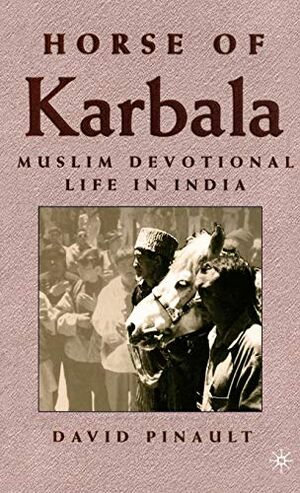Horse of Karbala: Muslim Devotional Life in India
 | |
| Author | David Pinault |
|---|---|
| Language | English |
| Genre | Historic |
| Published | 2001 |
| Publisher | Palgrave Macmillan |
| Pages | 287 |
The book Horse of Karbala: Muslim Devotional Life in India in the form of travelogue deals with the study of Muharram rituals and interfaith relations that commemorate an event of vital importance to Shia Muslims: the death of Imam Hussein, grandson of the Prophet Muhammad.
About the author[edit | edit source]
David Pinault, Ph.D., is a Professor of Religious Studies and the Director of the Arabic, Islamic, and Middle Eastern Studies program at Santa Clara University. His most Popular Books:
- The Shiites
- Museum of Seraphs in Torment: An Egyptological Fantasy Thriller
- Horse of Karbala: Muslim Devotional Life in India
- Notes from the Fortune-Telling Parrot: Islam and the Struggle for Religious Pluralism in Pakistan
- The Crucifix on Mecca's Front Porch: A Christian's Companion for the Study of Islam
About the book[edit | edit source]
This book published in Palgrave Macmillan US (March 8, 2001), has 287 pages and best sellers rank of 2,113,295 in Books. In Iran, it has been translated to Persian by Taha Rabbani in Arma publication.
The present book is a study of Muharram rituals in three locations in India: Hyderabad, Ladakh, and Darjeeling, in which Pinault in the form of a travelogue examines three different aspects:
1. Shi'a religious differences between present and past societies and the reforms made in them by the passage of time,
2. Attention to convergence and positive point between Islamic religious understanding and Christian religious understanding (Shiite Muslim and Christian religious life),
3. His own personal experiences as an American in India, researching about Shi'a communities,
Abstract of chapters[edit | edit source]
Chapter 1, Initiation: Hyderabad, 1989
This part is about the author who is transferred to Hyderabad to do academic research about Shi'ism and Shi'a religious ceremonies in Muharram in this city of India.
Chapter 2, An Introduction to the Shia Tradition in Islam
This part examines the history of the caliphs after Muhammad and how the incident of Karbala happened and Hussain was martyred. Moreover, it is about the explanation of rituals and ceremonies related to Abbas.
Chapter 3, Blood, Rationality, and Ritual in the Shia Tradition
In this part, while attending the ceremonies, Pinault shows the connection of these mourning ceremonies with the story of Gabriel and the choice of Adam. He also explains the Sufi connection with the martyr regarding the various types of death and love.
Chapter 4, "Would That You Could Bury Me, Too, Beside My Brother!": Women's Roles in Shi'a Devotional Literature
In this part, according to what is evident in Hyderabad ceremonies, Pinault talks about prominent Islamic women such as Fatima, Hussein's mother, Fatima Kubra and Sakina, Hussein's daughters, Zainab, Hussein's sister and Shahrbanoo, Hussein's legendary wife.
Chapter 5, Shia Ritual in a Sunni Setting: Muharram Observances in the Hill Station of Darjeeling, West Bengal
This part is dedicated to Pinault's second season of Muharram in India, in Darjeeling and is about how mourning ceremonies and rituals are prepared by non-Shi'a organizations. He believes that Muharram is a means of social interaction between Muslims and non-Muslims in Darjeeling.
Chapter 6, Horse of Karbala: Ladakh, Shia Ritual, and Devotional Literature Relating to Zuljenah
In this part the author discusses in greater detail Ladakhi Muharram liturgies linked to the Horse of Karbala. Here he provides a larger context for Ladakhi observances by examining historical evidence and classical Shi'a devotional literature (Arabic, Persian, and Urdu) for references to Zuljenah veneration, in Iran and elsewhere in the Islamic world, in the pre-modern period.
Chapter 7, Muslim-Buddhist Relations in a Ritual Context: An Analysis of the Muharram Procession in Leh Township, Ladakh
Pinault in this part uses Zuljenah procession as a way to talk about relations between Ladakh's Muslim and Buddhist populations. He hopes to demonstrate that the Zuljenah procession both masks and displays Shi'a-Sunni tensions within Leh district's Islamic community. At the same time, he argues, the Horse of Karbala ritual presents a show of monolithic Muslim solidarity for the benefit of Buddhist mourners.
Chapter 8, Shia Lamentation Rituals and Reinterpretations of the Doctrine of Intercession: Two Cases from Modern India
In this part the author brings together data from his fieldwork in Hyderabad and Ladakh in order to discuss the doctrine of intercession and liturgical actions linked therewith, focusing on reassessments of intercession and critiques of matam in the twentieth century. To provide a context for his field observations he begins with a review of devotional and doctrinal literature from the pre-modern era concerning intercession.
Chapter 9, The Day of the Lion: A Ladakhi Shi'a Ritual Determined by the Zodiacal Calendar
In this part Pinault discusses The Islamic calendar and the fact that it is lunar, and so holy days such as Muharram shift their date every year in relation to the solar calendar Whenever Muharram occurs in winter, he explained, Ladakh is hold a second, additional, series of rituals to commemorate the death of Hussain.
Chapter 10, Shia Encounters in the United States: Notes on Teaching the Shi'a Tradition in American Classrooms
In this part Pinault offers his Shiism course; and at semester's end one of his Shia students paid him the compliment of inviting him to speak at her mosque in the city of Pomona the topic: "Being Shia and Being American." After the speech, the congregation's reaction to his talk made the whole venture worthwhile.